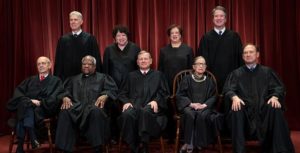You can count on your ten fingers the number of times the U.S. Supreme Court has ruled unanimously on any environmental issue. And you can count on the fingers of one hand the unanimous rulings on endangered species issues. In fact, you only need one finger to count those unanimous rulings, as it has only happened once in history. Until now. Until the dusky gopher frog.
 The only other time an endangered species case was decided by a unanimous Supreme Court was on a procedural question about who is allowed to sue the government. But a unanimous ruling issued a couple days after Thanksgiving settled a far more substantive issue, and in the process, dealt a serious setback to the concept of agency deference.
The only other time an endangered species case was decided by a unanimous Supreme Court was on a procedural question about who is allowed to sue the government. But a unanimous ruling issued a couple days after Thanksgiving settled a far more substantive issue, and in the process, dealt a serious setback to the concept of agency deference.
The “deference” idea simply means that if an agency makes decisions in implementing a law, and the law itself is vague on some detail, the courts will “defer” to the agency’s judgment and expertise, as long as the interpretation seems “reasonable.” It is often called “Chevron deference,” because it came from a 1980s power plant case involving Chevron. It was a bad idea then, and it is a bad idea now. It has been abused by numerous agencies, empowered by the idea that no court is smart enough to second guess their expertise. In fact, many feel it is inappropriate even for Congress to question their judgment. After all, Congress delegates implementation authority to agencies precisely because of their expertise, right?
Wrong. Congress delegates authority over details, and over day-to-day management, because it cannot do everything itself. But it has never – and can never – delegated the people’s sovereign authority to make policy. When agency interpretations equate to legal policy, as they often do, it is entirely appropriate for others to review those judgments. In the case of the dusky gopher frog, one agency, the U.S. Fish and Wildlife Service (USFWS), went too far.
The case attracted voluminous media attention over the past couple years, because it was about a cute little animal. The dusky gopher frog was listed as endangered in 2001. It once inhabited much of the Deep South, but today is found at only one pond in Mississippi. The frogs only reproduce in “ephemeral” ponds that run dry part of the year, so there are no predatory fish, and they thrive only in “open-canopy” forests that frequently burn.
The USFWS designated 1,544 acres of private land in Louisiana as “critical habitat” – land that does not satisfy that description. Never mind that no dusky gopher frog has lived there for at least a half century, and none could live there without “substantial modification” of the land. That would mean no further business activity, and the loss of $34 million in value. These facts were disputed by neither side.
The agency expected the courts to “defer” to its judgment on what constitutes “critical habitat.” What they got instead was an elementary grammar lesson. The Supreme Court – unanimously – reminded the agency that “critical” is the adjective and “habitat” is the noun. Land cannot be critical habitat if it is not habitat at all. No more than something can be called yellow mustard that is in fact ketchup.
The dusky gopher frog case will have ripple effects in numerous other cases, because USFWS has designated “critical habitat” in many, many areas where a protected species does not actually live. That may also include numerous areas where the species cannot live, even if it once did, because the habitat has been changed and cannot be restored without massive economic upheaval. Think about the wildlife that once inhabited the Great Plains, for example, which is now the agricultural breadbasket of the world. Should the government be allowed to stop the agriculture that sustains our lives because millions of bison once lived there?
By the way, both sides of environmental disputes will attempt to use this new ruling to their advantage. The environmental lobby is just as likely as energy companies to go to court, questioning agency interpretations. Nor can we always trust courts to get it right, obviously. But I am far more comfortable today, knowing that even the all-powerful enforcers of the Endangered Species Act can be reined in when they go too far.
Even justices as different as Clarence Thomas and Ruth Bader Ginsburg can agree on that. Trying to control private land, even to the point of stopping legitimate business activity, by declaring it habitat for a species that does not live there, is going too far.
A version of this column first appeared in the Grand Junction Daily Sentinel January 11, 2019.




Well stated and summarized, Greg. Hope all is well with you and your family.
Comments on this entry are closed.